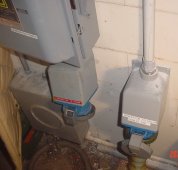NakeDiesel
New Member
- Joined
- Jul 22, 2022
- Messages
- 13
We have been planning on moving towards solar in the future, but it's a multi step process for us, we have other items we need to get done before we get to that point. I just had all our windows replaced in the house (22k worth), and I am getting ready to start residing our house this fall with adding double bubble insulation and steel ag panels and trim now that the windows are on to further seal the house up.
The first step towards solar is to add a backup generator and ATS. We have been having a lot of power issues from PSO here lately, power going on and off with storms, several times a week for hours at a time and with me working from home, puts a damper on the work day. I've installed an Emporia 16 node monitor on our house panel and been monitoring it, with both HVAC systems being hammered in our 100+ days it looks like we have been hitting peaks of 15.7 kw max over the last few days I've had it installed.
Presently the house has 2 HVAC systems with 2.5 ton AC systems and propane 60k BTU furnaces, both of which are 20 years old, those are in the plans to get replaced in the next year as well and we are planning that out with my buddy that's an HVAC dude. Most likely going with the Mistsubishi Intelli Heat pump system (haven't decided on hyper heat or regular yet) with a goodman 60k 97% propane furnace for backup heat.
I'd initially thought of going with a 20kw backup genset on propane, but looking at the consumption we have on our current peak high usage days with high heat, I'm wondering if we can't get away with an 18kw generator.
I won't be running my well on this, I'll be installing a plug for my trailer mounted 10kw welder/gen to run it if needed if we are out for a long term situation.
Any thoughts?
The first step towards solar is to add a backup generator and ATS. We have been having a lot of power issues from PSO here lately, power going on and off with storms, several times a week for hours at a time and with me working from home, puts a damper on the work day. I've installed an Emporia 16 node monitor on our house panel and been monitoring it, with both HVAC systems being hammered in our 100+ days it looks like we have been hitting peaks of 15.7 kw max over the last few days I've had it installed.
Presently the house has 2 HVAC systems with 2.5 ton AC systems and propane 60k BTU furnaces, both of which are 20 years old, those are in the plans to get replaced in the next year as well and we are planning that out with my buddy that's an HVAC dude. Most likely going with the Mistsubishi Intelli Heat pump system (haven't decided on hyper heat or regular yet) with a goodman 60k 97% propane furnace for backup heat.
I'd initially thought of going with a 20kw backup genset on propane, but looking at the consumption we have on our current peak high usage days with high heat, I'm wondering if we can't get away with an 18kw generator.
I won't be running my well on this, I'll be installing a plug for my trailer mounted 10kw welder/gen to run it if needed if we are out for a long term situation.
Any thoughts?






